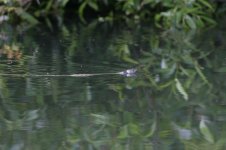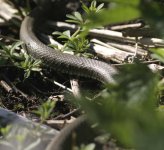Last Saturday i decided to have a walk by the river not far from my home. After about a hour observing the wildlife i decided to head back home, walking along the path i noticed something on the ground moving.
As i got a little closer i realised it was a Snake, it was a large Grass Snake about 1.5 metres long. I could not belive my eyes it was such a shock.
It is something i will never ever forget, it was beautiful as it disappeard into the hedge.
A huge first for me and i was delighted, one thing that sticks in my mind was the large yellow patch just behind its head.
Can someone tell me was it a male or female.
As i got a little closer i realised it was a Snake, it was a large Grass Snake about 1.5 metres long. I could not belive my eyes it was such a shock.
It is something i will never ever forget, it was beautiful as it disappeard into the hedge.
A huge first for me and i was delighted, one thing that sticks in my mind was the large yellow patch just behind its head.
Can someone tell me was it a male or female.






